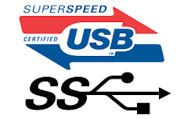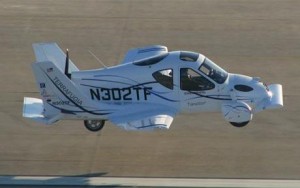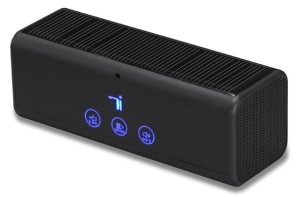The first set of USB 3.0 compatible consumer products were premiered at the International Consumer Electronics Show (CES) at Las Vegas recently. The USB Implementers Forum (USB-IF) hade earlier announced the first 17 consumer productsincluding host controllers, adapter cards, motherboards, and hard drives (but no other consumer electronics devices), to pass compliance and certification testing for SuperSpeed USB, the next generation of USB technology. Still more uncertified USB 3.0 products are on the way, and they can’t get here fast enough.
The products certified SuperSpeed USB motherboards, notrbook PC systems, consumer devices and enabling device silicon. The first wave of certified SuperSpeed USB consumer products abd devices to enter the market are from manufacturers including ASMeia Technology, Asus, Fujitsu, Giga-Byte Technology, HP, I/O Interconnect, LucidPort Technology, RATOC Systems, SIIG, Symwave and Western Digital.
he president of the USB Implementers Forum discussed the arrival of USB 3.0 and gave a brief demonstration of transfer speeds on a Hewlett-Packard laptop at the Consumer Electronics Show.
In case anyone was in doubt, USB 3.0 is a lot faster than the current 2.0 version. USB 3.0 is now available to consumers on laptops from HP and Asus, among others.
USB is also more power efficient than 2.0. “This uses one-third of the power it would take on USB 2.0,” said Ravencraft, in an interview at CES. “And it’s backward compatible,” he said, meaning it can also handle peripherals that use older USB standards.
And speaking of peripherals, Western Digital has announced a new WD My Book based on the USB 3.0 specification with an adapter card, which will make an existing desktop PC USB 3.0-compatible.
Also, cards that go into a laptop’s ExpressCard slot are available, Ravencraft said. This allows an existing laptop to be upgraded to 3.0.
HP is now offering an Envy 15 laptop model with USB 3.0 connectors, and Acer was showing a raft of laptops on the CES show floor with the new standard, including the NX90Jq.
The beauty of USB 3.0 is its backward compatibility with USB 2.0; you need a new cable and new host adapter (or, one of the Asus or Gigabyte motherboards that supports USB 3.0) to achieve USB 3.0, but you can still use the device on a USB 2.0 port and achieve typical USB 2.0 performance.
The theoretical throughput improvement offered by USB 3.0 is dramatic — a theoretical 10X jump over existing USB 2.0 hardware. USB 2.0 maxed out at a theoretical 480Mbps, while USB 3.0 can theoretically handle up to 5Gbps. Mind you, applications like storage will still be limited by the type of drive inside; so, for example, you can expect better performance from RAIDed hard drives or fast solid-state drives (SSDs) than from, say, a standalone single drive connected to the computer via USB 3.0.
The real-world examples are fairly convincing — and underscore USB 3.0’s advantage for high-def video, music, and digital imaging applications.
Before, in the transition from USB 1.1 to USB 2.0, the USB 2.0 spec was written in a way where it “encompassed low, full and high-speed USB,” explains Ravencraft, president and chairman of the USB Implementers Forum. “Since those are all encapsulated in the USB 2.0 spec, [vendors] could have a certified product that’s low-speed, but still call it USB 2.0.
“We don’t have that issue with USB 3.0 To claim you’re USB 3.0, you have to deliver 5Gbps. There’s no other way to get the certification.”
Ravencraft adds that the group is prepared to protect the USB 3.0 logo, to make sure that only manufacturers who go through certification use it. “We’ll take legal action if anyone infringes on our marks.”
According to In-Stat Research, by 2013, more than one-quarter of USB 3.0 products will support SuperSpeed USB 3.0.
Fujitsu Microelectronics America, Inc. (FMA) demonstrated the interoperability of its USB 3.0-SATA Bridge IC for PC peripherals at the USB TechZone #30769 during CES Las Vegas 2010, January 7-10.
The following products have achieved compliance and certification for SuperSpeed USB.
Motherboards
Asus – P6X58D Premium motherboard.
Giga-Byte Technology – GA-P55A-UD3 motherboard
Notebooks
HP – Envy 15 notebook PC
Fujitsu – FMV-BIBLO NF/G70 notebook PC
Consumer devices
I/O Interconnect – RS952, USB 3.0 2.5″ hard disk drive enclosure
RS954, USB 3.0 3.5″ hard disk drive enclosure
RA314, USB 3.0 0.2- port PCIe add-in-card
RA315, USB 3.0 2-port ExpressCard
RATOC systems – USB 3.0 PCIe add-in card, USB 3.0 ExpressCard
SIIG – JU-P20412-S2, USB 3.0 2-port PCIe add-in card
Wetern Digital – My Book USB 3.0 external hard drive
USB 3.0 PCIe (Gen 2) adaptor card
Device Silicon
ASMedia Technology – ASM1051, USB 3.0 to SATA storage controller
Fujitsu Microelctronics – MB86C30, USB 3.0 to SATA storage controller
LucidPort – USB300, USB 3.0 to SATA storage controller
Symwave – SW6316, USB 3.0 to SATA storage controller




